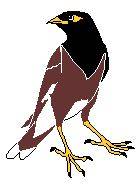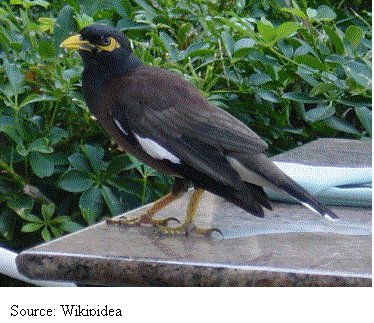Classification Hierarchy:
| Kingdom - Animalia | |||||
| Phylum - Chordata | |||||
| Subphylum - Vertebrata | |||||
| Class - Aves | |||||
| Order - Passeriformes | |||||
| Family - Sturnidae | |||||
Local names : Desi myna in Hindi, Gorwantera (Kannada), Goranka (Telegu), Nahanavai (Tamil), Hor (Kashmiri), Salik or Bhat salik (Bengali), Kavalamkili, Matatta (Malayalam), Hirtenmaina (German), Tserikamena ( Madagascar)
 |
General description, Size, shape and colour: The myna bird is about 23 cm long, about 110 gm in weight, a little smaller than a dove, bigger than a bulbul. The common myna's head and neck are black. The back and breast are brown. The head of the bird is well groomed. The beak, legs and skin patches behind the eyes are dark yellow and it has white tail tips. The sexes look alike. Flight: Wing patches flash when the bird flies. Myna beats its wings 5.1 per second. Call : Have a variety of calls radio-radio-radio, keek-keek-keek, kok-kok-kok, chur-chur, etc. |
Breeding: Common mynas begin nest building in late February and March. The nests in urban areas are often found in houses or buildings, attic, drain pipes, on top of windows. Twigs, grass and leaves are used to build the nests, as well as cellophane, string, paper and even snakeskin. Snake_skin is draped around the nest to scare off enemies. Nests are sometimes built in trees, especially in coconut and date palms . Both male and female mynas help build the nest. When courting, the male brings nesting material and places it in front of the female, who adds it to the nest. Nests may be used more than once and new nests may be built on top of old ones. The mynas are aggressive in defending their nesting territory from other birds or predators. Egg-laying takes place between March and July. Each nest has two to five eggs, which are a blue to blue-green color. Both adults take turns to incubate, or sit over the eggs. The chicks hatch after 13 to 18 days. They are fed and brooded (protected in the nest) by both parents. They are fed insects and earthworms for the first ten to twelve days, and each chick must be fed as often as 15 times every hour. At about one month of age the young birds, called fledglings, are able to fly and are ready to leave the nest. They spend another month with the parents, being fed occasionally and learning to feed themselves.
Habitat: |
In the evening common mynas gather in large flocks to roost, usually on banyan tree. Their noisy calls continue until dark. They begin their calling in the morning before dawn and stay in the roosting tree for a time before they leave to begin feeding. Mynas feed in pairs or in small flocks. They are omnivorous feeders - they eat both plant and animal materials. Besides eating insects and worms, they also eat fruit, grain and food scraps. In its native India, the common myna is called the "Farmer's Friend" because it eats insects that destroy crop plants. While the common mynas are very helpful in controlling insects, they do cause some problems. They damage crops, spread weeds and often spread mites (tiny parasites) to other birds and to homes where mynas nest. They sometimes interfere with the nests of other birds. Have a variety of calls radio-radio-radio, keek-keek-keek, kok-kok-kok, chur-chur, etc. |
Distribution: Common mynas are natives of India, Sri Lanka, Pakistan and Nepal. They were introduced in many other countries as pets as good in mimicry as well as intelligent bird. Few of them, which were released or escaped, have firmly established and feral in South Africa, Australia, New Zealand, Solomons, New Caledonia, Fiji, Western Samoa, Cook Islands, Hawaii and some other oceanic islands.
Importance:
Ecological – Pest control, enrichment of soil
Economic – So many Hindi songs on them
- Bhutan, Aitutaki, Ascension islands, Laos, etc, have issued stamps depicting myna.
References:
- Salim Ali,(2002). The book of Indian Birds, 13 th Edition, Oxford University Press.
- Wild Life in Madagascar
- Hawaii Nature Focus
- Bird stamps
- Birds of New Zealand
| Address for Correspondence | Top |
Energy & Wetlands Research Group,
Centre for Ecological Sciences,
Indian Institute of Science,
Bangalore - 560 012.